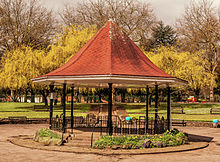History in Britain
The parks where most bandstands are found were created in response to the Industrial Revolution, when local authorities realized worsening conditions in urban areas meant there was an increasing need for green, open spaces where the general public could relax. The first bandstands in Britain were built in the Royal Horticultural Society Gardens, South Kensington in 1861. Bandstands quickly became hugely popular and were considered a necessity in parks by the end of the 19th century.
To assist the war effort during World War II, iron fittings were removed from many bandstands to be melted down and transformed into weapons and artillery. Many bandstands fell into disrepair and were boarded up in the late 1940s and 1950s. Other attractions – such as the cinema and television – were becoming increasing popular and traditional recreational parks lost much of their appeal.
Between 1979 and 2001, more than half of the 438 bandstands in historic parks across the country were demolished, vandalized or in a chronic state of disuse. In the late 1990s the National Lottery and Heritage Lottery Fund invested a substantial sum in the restoration and rebuilding of bandstands across the country. As a result of this funding, over eighty bandstands were either fully restored or replaced. Between 1996 and 2010 there was over £500 million worth of investments in parks - a significant chunk of this money was spent on the restoration and building of bandstands. [1]
History in United States
Gazebo bandstands appeared in the United States after the Civil War (1861–65) to accommodate the brass and percussion "cornet" bands found in towns of every size. Styles ranged from exotic ″Moorish″ designs to ordinary wood pavilions with mill work trim. They were found in parks, court house squares and fairgrounds. Following the Worlds Columbian Exposition (world's fair) of 1893 in Chicago, amusement parks based on the famous Midway became popular. These were often established by trolley companies to provide a trolley destination on weekends. Bandstands and dance pavilions were an essential feature of these parks. Most are no longer in existence.
After 1900, rectangular pavilions enclosing a stage and acoustical shell providing directional sound appeared in many parks. Styles of acoustical shells took several forms during the 20th century. In 1913 Frank Lloyd Wright designed a freestanding bandshell with edge–supported cantilever roof and no side posts for his Midway Gardens (demolished 1929) in Chicago. [2] Variations on this design were built later in the century.
The 1928 Hollywood Bowl shell in California designed by Wright's son Lloyd Wright was a prototype for the streamlined concrete bandshell of the 1930s. Many of these shells with their distinctive concentric arches survive as landmarks in parks across the US.
Preservation of historic bandstands is by local initiative. Some are on the National Register of Historic Places, usually as part of a historic district. Continuous use as performing venues is a good incentive to keep them maintained. When this is not possible they must be maintained solely as historic landmarks. In many places a succession of bandstands, sometimes as many as three or four, were built on the same site. Because of this practice it is important to preserve postcards and photographs of earlier structures as a historical record.

Historically, a kiosk was a small garden pavilion open on some or all sides common in Persia, the Indian subcontinent, and in the Ottoman Empire from the 13th century onward. Today, several examples of this type of kiosk still exist in and around the Topkapı Palace in Istanbul, and they can be seen in Balkan countries.

A gazebo is a pavilion structure, sometimes octagonal or turret-shaped, often built in a park, garden, or spacious public area. Some are used on occasions as bandstands.
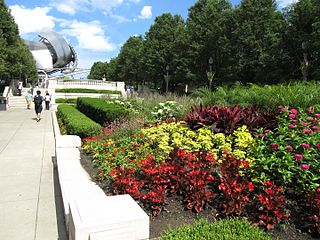
Millennium Park is a public park located in the Loop community area of Chicago, operated by the Chicago Department of Cultural Affairs. The park, opened in 2004 and intended to celebrate the third millennium, is a prominent civic center near the city's Lake Michigan shoreline that covers a 24.5-acre (9.9 ha) section of northwestern Grant Park. Featuring a variety of public art, outdoor spaces and venues, the park is bounded by Michigan Avenue, Randolph Street, Columbus Drive and East Monroe Drive. In 2017, Millennium Park was the top tourist destination in Chicago and in the Midwest, and placed among the top ten in the United States with 25 million annual visitors.
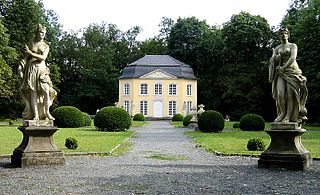
In architecture, pavilion has several meanings;

Lake Harriet is a lake in southwest Minneapolis, south of Bde Maka Ska and north of Minnehaha Creek. The lake is surrounded by parkland as part of Minneapolis’ Chain of Lakes. The lake has an area of 335 acres (1.36 km2) and a maximum depth of 85 feet (26 m).

The CNE Bandshell is an open-air concert venue in Toronto, Ontario, Canada. It is located at Exhibition Place on the shores of Lake Ontario. Built in 1936, it hosts the annual music program of the Canadian National Exhibition (CNE) and is also used for festivals and picnic events, for which the "Bandshell Park" can be rented from the City of Toronto.
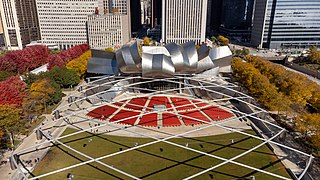
Jay Pritzker Pavilion, also known as Pritzker Pavilion or Pritzker Music Pavilion, is a bandshell in Millennium Park in the Loop community area of Chicago in Cook County, Illinois, United States. It is located on the south side of Randolph Street and east of the Chicago Landmark Historic Michigan Boulevard District. The pavilion was named after Jay Pritzker, whose family is known for owning Hyatt Hotels. The building was designed by architect Frank Gehry, who accepted the design commission in April 1999; the pavilion was constructed between June 1999 and July 2004, opening officially on July 16, 2004.

The Charles River Esplanade of Boston, Massachusetts, is a state-owned park situated in the Back Bay area of the city, on the south bank of the Charles River Basin.

Overton Park is a large, 342-acre (138 ha) public park in Midtown Memphis, Tennessee. The park grounds contain the Memphis Brooks Museum of Art, Memphis Zoo, a 9-hole golf course, the Memphis College of Art, Rainbow Lake, Veterans Plaza, the Greensward, and other features. The Old Forest Arboretum of Overton Park, one of the few remaining old growth forests in Tennessee, is a natural arboretum with labeled trees along trails.
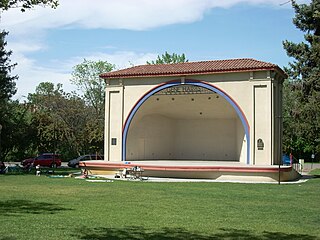
In theater, a shell is a curved, hard surface designed to reflect sound towards an audience.

Julia Davis Park is a municipal park in the western United States, located in the downtown region of Boise, Idaho. Created in 1907 with a land donation from Thomas Jefferson Davis, it is the first park in the "String of Pearls", a series of parks along the Boise River operated by the city's Parks and Recreation Department.

The Oleson Park Music Pavilion, also known as the Karl King Bandshell, is located in Fort Dodge, Iowa, United States. The pavilion is associated with Karl King, a famed composer for concert and military bands, who advocated for its construction. It was designed by Henry L. Kamphoefner, a Sioux City architect at that time, who had previously designed the Grandview Park Music Pavilion in Sioux City. It was built as a Works Progress Administration (WPA) project. The WPA paid for 85% of its construction, with the City of Fort Dodge paying the rest. The poured concrete structure was built in a Modernist style with Art Deco overtones. It rises to a height of 36 feet (11 m), and it is known for its acoustical excellence. The pavilion replaced a bandstand that was built in the 1920s in the city square. It was dedicated to King in 1976, and listed on the National Register of Historic Places in 2003.

The Petrillo Music Shell is an outdoor amphitheater in Grant Park in the Loop community area of Chicago in Cook County, Illinois, United States. It serves as host to many large annual music festivals in the city such as Chicago Blues Festival, Chicago Jazz Festival, Taste of Chicago and Lollapalooza.

The LeClaire Park Bandshell, also known as the W.D. Petersen Memorial Music Pavilion, is located on Beiderbecke Drive in LeClaire Park, Davenport, Iowa. It was listed on the National Register of Historic Places in 1983 and on the Davenport Register of Historic Properties in 1993.

The Central Park Bandstand, also known as the Music Pavilion, is a historic bandshell located within Central Park in Orion, Illinois. The bandstand was built in 1913 following a series of successful outdoor concerts in the park. Local engineer J. C. Ericson built the structure in the then-recently popularized bandshell form, which projected sound toward the audience through its rear wall. The bandstand was completed in three weeks; its opening concert hosted the largest crowd that the park had ever held until that time. From its inception until 1925, the bandstand continued to host concerts, usually once per week; movie screenings and church services were also held at the bandstand. Beginning in 1947, the bandstand became an event stage for the Midwest Corn Show, which later became the Orion Fall Festival; the structure is now mainly used during the festival.
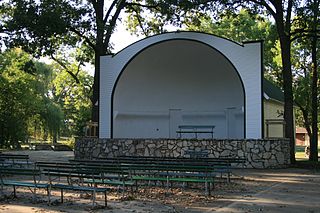
The East Park Band Shell is a historic structure located in Mason City, Iowa, United States. The band shell was individually listed on the National Register of Historic Places in 2009. In 2014 it was included as a contributing property in the East Park Historic District.

Bandshell Park, also known as City Park and Music Pavilion, is located in Ames, Iowa, United States. It is a nationally recognized historic district that was listed on the National Register of Historic Places in 1999. At the time of its nomination it consisted of six resources, which included one contributing building, one contributing site, two contributing structures, one contributing object, and one non-contributing object. The park, located to the east of the central business district, was gift to the city in 1884 from the C&NW Land Company. The full city block was the first park established in Ames.

Wentworth Park is a Canadian urban park located in the community of Sydney, part of Nova Scotia's Cape Breton Regional Municipality. The park was created in 1786, just a year after Sydney's founding, making it the oldest of Sydney's parks. Wentworth Park incorporates the Kiwanis Bandshell, a playground, fountains, and a splash pad, as well as a 1.2 kilometres (0.75 mi) network of paved paths surrounding the park's ponds and flower beds.

Spreckels Temple of Music, also called the bandshell, constructed in 1900, is in the Music Concourse at Golden Gate Park in San Francisco. It was a gift to the city from sugar magnate Claus Spreckels and is one of the largest bandshells in North America.




